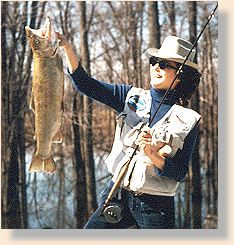 To the fly fisher the Pere Marquette, or P.M. as it is locally known,
is a world class trout and salmon river. It can provide the ultimate
sporting challenge and enjoyment. Whether you're matching minutiae
with delicate size 4 Tricos to selective August trout;
fishing early summer big bugs like gray drakes and Hexeganias
to night feeding lunker browns, or chasing wild steelhead and Chinook
salmon in the 30 pound range, the Pere Marquette has something for
everyone. Many anglers are called to this river each year. But few allow
this gentle lady to reveal herself. She gives patiently and selectively
to those willing to learn her ways and pay their dues to understand
her.
To the fly fisher the Pere Marquette, or P.M. as it is locally known,
is a world class trout and salmon river. It can provide the ultimate
sporting challenge and enjoyment. Whether you're matching minutiae
with delicate size 4 Tricos to selective August trout;
fishing early summer big bugs like gray drakes and Hexeganias
to night feeding lunker browns, or chasing wild steelhead and Chinook
salmon in the 30 pound range, the Pere Marquette has something for
everyone. Many anglers are called to this river each year. But few allow
this gentle lady to reveal herself. She gives patiently and selectively
to those willing to learn her ways and pay their dues to understand
her.
The watershed was inhabited as early as 10,000 B.C. Paleo Indians
wandered north in search of game fish, wild fruit and vegetables. . .
Around 1000 A.D., the Great Lakes Indian population was dominated
by the Ottawa, Ojjbwan (Chippewa) and Pottawatomi . . . these Indians
named Lake Michigan after their word for "great water" - Kitchigami.
In the spirit of manifest destiny, the French government assigned
Louis Jolliet to explore the Great Lakes and head waters of the Mississippi.
Jesuit missionaries provided spiritaul bonding with Indian tribes and
established settlements. It was during this westward migration the Father
Jacques Marquette joined Jolliet and began to work his magic with the
natives. He was a very kind, knowledgable and charismatic man . . . The
indian natives of this area who were immensely dedicated to him and loved
him dearly named the river, "The River of the Black Robe," after the Jesuit
garment that he wore.
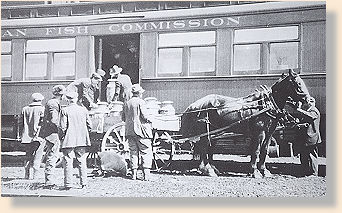
Aside from the beneficial impact that Jacques and Marquette had on the entire
area, perhaps no other man influenced the river as indirectly as Fred Mather.
As an angler, fish culturist, and U.S. delegate to the 1880 International
Fisheries Exposition in Berlin, he met Baron Von Behr, President of the
German Fishing Society. After taking Mather to fish for Black Forest brown
trout, Mather was amazed by their cunning tenacity and beauty. Von Behr
promised to send Mather some eggs. In February of 1883, a batch of eggs
arrived in New York where they were divided between the New York State
hatcheries in Cold Spring, Caledonia and the U.S. Fish Commissions's
hatchery at Northville, Michigan. The U.S. Fish commission hoping to
restore raped watersheds [from timbering] were eager to embark on a new
and prosperous era. New hatched fry were transported to the Pere Marquette
in 1884, thus giving it the honor of the first brown trout stocking in the
United States. The fish adapted to the slowly healing watershed and the rest
is history.
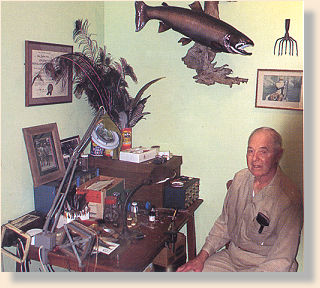 By the early 1920s, the river had become a haven for corporate Midwest
businessmen in pursuit of trout. The Pere Marquette Railroad established
access to the river and soon many prestigious fishing clubs emerged, similar
to the Catskills. With fishermen came guides who quickly took advantage of the
25 fish creel limits and hammered the river. Yet the bounty of fish increased with
the return of the second growth forest. Early P.M. guide boats were about 15
feet long and steered by poles made of ash or maple. Weathly corporate clients
used Garrison bamboo rods and custom tied flies in search of sassy and selective
wild browns. The Pere Marquette was back - healthy, beautiful and full of trout.
By the early 1920s, the river had become a haven for corporate Midwest
businessmen in pursuit of trout. The Pere Marquette Railroad established
access to the river and soon many prestigious fishing clubs emerged, similar
to the Catskills. With fishermen came guides who quickly took advantage of the
25 fish creel limits and hammered the river. Yet the bounty of fish increased with
the return of the second growth forest. Early P.M. guide boats were about 15
feet long and steered by poles made of ash or maple. Weathly corporate clients
used Garrison bamboo rods and custom tied flies in search of sassy and selective
wild browns. The Pere Marquette was back - healthy, beautiful and full of trout.
The Tributaries
It is to the Wisconsin glaciation and other glacial upheavals that occured over
the past 130 million years, that the Pere Marquette watershed spreading over
494,000 acres and 762 square miles owes its primordail character and origins . . .
Deep glacial sands dominate the entire geography and nourish every drop of
water and assure the P.M. watershed a consistent flow of cool, clear water.
Each springtime, when the woods are still barren and the snows have long
melted, I revel in driving the backroads near the Little South Branch, Middle
Branch and Baldwin Rivers to see springs and tiny rivulets gushing forth next
to roadside ditches, peoples' backyards and flowing from marl swamps and
bogs. Watercress and other alkaline loving plants flourish in these springs along
with the seasons's first wildflowers and mushrooms. These tiny veins and
capilaries form complex networks that make the P.M. watershed a diverse and
great trout and salmon rookery. Fry, fingerlings and smolts abound in nursery
waters flowing over fine gravel. The dense forest provides downed trees and
stumps (known as sweepers) that harbor excellent native populations of three
species of trout. For the small stream fly rodder, the tributaries of the P.M. can
take a lifetime to explore. From wet fishing for wild brook trout, grasshopper
action for plump browns, or battling large migrating steelhead and salmon in
close and challenging quarters, the tributaries provide peace and solitude for
the exploring angler. Even the locals know suprising little about the abundance
and diversity that these waters possess. [Tributaries include: The Little South
Branch, The Middle Branch, The Baldwin River, and The Big South Branch.]
The Steelhead
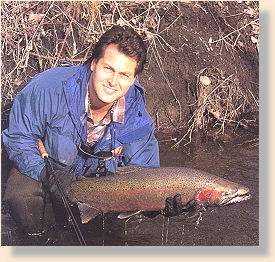 Natural dynasties rarely are induced, the story of the wild Pere Marquette
steelhead is an exception to the rule. Few would have thought that a small
planting of 25,000 McCloud River, California strain fingerlings in 1883
on the Little South Branch would signal the start of a world-class steelhead
fishery. But the renaissance of the West Coast steelhead plantings throughout
Michigan's Great Lakes between 1880 and 1893 including Klamath and other
West Coast strains which fused genetically with each other, found the cool,
gravely waters of the P.M. to their liking. The river was poised to create
an empire for the migrating rainbow.
Natural dynasties rarely are induced, the story of the wild Pere Marquette
steelhead is an exception to the rule. Few would have thought that a small
planting of 25,000 McCloud River, California strain fingerlings in 1883
on the Little South Branch would signal the start of a world-class steelhead
fishery. But the renaissance of the West Coast steelhead plantings throughout
Michigan's Great Lakes between 1880 and 1893 including Klamath and other
West Coast strains which fused genetically with each other, found the cool,
gravely waters of the P.M. to their liking. The river was poised to create
an empire for the migrating rainbow.
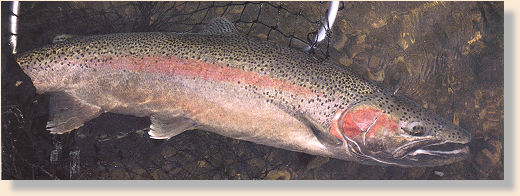
By 1914 runs of steelhead were so thick on the Pere Marquette that laws were
being considered to allow for spearing or netting. As a result of modern sport
fishing technology benefiting charter captians and stream fly fishers, angling
pressure and the stress it puts on a watershed have kept the annual run in a state
of balance, with both good and bad years running in a cyclical fashion. P.M.
steelhead are here to stay. Leo Mroziski, District Biologist for the Michigan
Department of Natural Resorces says, "the runs are in excellent shape. Good
spawning gravel and holding water are found in the entire watershed including
the tributaries. With the lack of dams and obstacles to movement, steelhead
trickle up every inch of the Pere Marquette system."
Wild Chinook
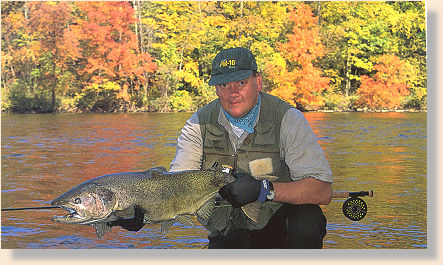
Last fall while wading the P.M. with its grand display of radiant fall foliage as
my backdrop, I hooked 10 to 15 Chinook, [King Salmon], some over 20
pounds, each day. Landing them was another matter. Fresh in the river,
they aggressively took my flies and provided me with crashing leaps and
freight-train runs, pummeling my shoulders, back and knees. These fish
had the tenacity and muscle of a fresh Atlantic salmon or steelhead. As far
as this fly angler is concerned, Michigan never had it so good. Wild Chinook
are here to stay on the P.M.
Hatches
The aquatic and terrestrial insect life of the Pere Marquette is astonishingly
rich and diverse. Perhaps second only to the AuSable River near Graying
[Michigan] in terms of insect numbers and diversity, the P.M. can easily
be labeled one of the finest hatch-matching rivers in the country. From
its ice-cold tributaries with aquatic vegetation and gravelly riffles it provides
ideal habitat for free swimming and clinging mayflies and stonefilies. The
main rivers diverse structure of pool, riffle and silt-ridden eddies provide
excellent habitat for the above mentioned species in addition to caddis and
the large burrowing drakes like the Hexgenia and Siphlonurus . . .
Though Pere Marquette trout are usually very opportunistic feeders, having
to brave bitterly cold winters and the onslaught of migrating salmon and
steelhead, the dense hatching period can find them selective about imitation
and presentation. There are times during the gray drake and Isonychia
hatches when there are a ridiculous amount of insects on the water - blanketing
every square inch.
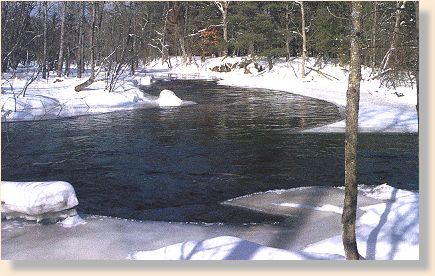
On warm winters day in January and February tiny winter black stoneflies
(Allocapnia and Nemouridae) hatch
during sunny afternoon periods.
It is the early black stone (Taeniopteryx) that
makes it's heaviest impack on the trout and steelhead in March and
April. The early brown or olive stone (Brachyptera),
medium brown stone (Periodidae), and little yellow
and green stone (Alloperia) are intermittently scattered
from April through October. . . The Pere Marquette is notorious for
complex hatches. Close inspection is required especially with stonefly
and caddis hatching.
The giant Pteronarcys dorsata, or Midwest salmonfly
averaging about size 2 to 6, stir up a lot of feeding commotion when they
hatch during evening and early morning hours of May through early
July.
The first mayfly of prominence to emerge in spring is the Hendrickson
(Ephemerella subvaria). The hatch is very predictable on
the P.M. with the afternoon period from noon to three showing the greatest
emergence of these pinkish-gray flies from late April through May. Hatching
simultaneously with the Hendricksons are blue-winged olives (Baetis
vegans) and slate-winged mahoganys (Paraleptophebia adoptiva)
.
The marl-bogged and tea-colored Pere Marquette, with its sluggish silted
eddies and tributaries produce some of the most amazing black quill
(Leptophlebia cupida) hatches in the country.
Perhaps the most spectacular and unique hatch of the Pere Marquette
is the emergence of the gray drakes Siphlonurus quebencensis,
rapidus and alternatus.) Beginning about the
third week in May and lasting until mid June, spinners blanket the entire
system at dusk, creating black clouds above the riffles.. .the
brown drake (Ephemera simulans) has a brief but important
hatch period near the middle to late June. . .
Though the sulphurs Ephemerella dorothea and lighter
stenonemas) are pleasant hatches to fish, they tend to
be unpredictable from year to year. Memorial Day weekend to the middle
of June will see the greatest numbers.
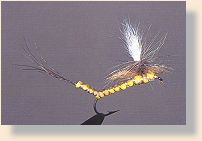 The lower P.M. has excellent, if not unpredictable hatches of the giant
Michigan mayfly Hexagenia limbata. This fabled hatch
that stirs up visions of 10 pound browns slashing at giant patterns in the
wee hours of the night . . . usually starts around the second week in June
and can go well into July.
The lower P.M. has excellent, if not unpredictable hatches of the giant
Michigan mayfly Hexagenia limbata. This fabled hatch
that stirs up visions of 10 pound browns slashing at giant patterns in the
wee hours of the night . . . usually starts around the second week in June
and can go well into July.

Late summer fishing is a hodgepodge of minutae and terrestrials with
reliable nightly caddis hatches. The Trico hatch is very
heavy on the P.M. and often overlooked by anglers chasing summer
steelhead. Terrestrials such as grasshoppers . . . crickets, ants and
beetles are abundant and relished by summer trout. Since the P.M.
usually has water temperatures comfortable for daytime trout activity
even during the hottest summers, terrestrials are playing a more important
role on this classic hatch-matching river.
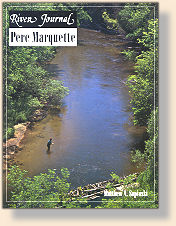
When not hatch-matching, P.M. anglers hammer the under-cut banks, log
jams and deep pools with "chuck-and-duck" streamers . . .and any other
large uglies that spell food or agression to lunker brown, salmon or
steelhead. Using lead-head patterns or sink-tips, it's important to fish
close to bank structure to smack the big one.
The choice is yours on the Pere Marquette. It offers the anglers delicate
dry fly fishing or "chuck-and-duck' bombardiering. The P.M. allows our
fly fishing personality to develop and demands that we know our bugs.
She's a tough river for those who take her lightly. Her tea-colored waters
flow bitter-sweet - giving and punishing. ~ Matthew A. Supinski
For a MAP of The Pere Marquette River, click here.
For the FLIES for The Pere Marquette River, click here.
To ORDER The Pere Marquette River direct from the publisher, click
HERE.
Credits: From Pere Marquette part of the River
Journal series, published by Frank Amato Publications.
We greatly appreciate use permission. Photos of the LadyFisher and Castwell from
FAOL file photos.
|







 By the early 1920s, the river had become a haven for corporate Midwest
businessmen in pursuit of trout. The Pere Marquette Railroad established
access to the river and soon many prestigious fishing clubs emerged, similar
to the Catskills. With fishermen came guides who quickly took advantage of the
25 fish creel limits and hammered the river. Yet the bounty of fish increased with
the return of the second growth forest. Early P.M. guide boats were about 15
feet long and steered by poles made of ash or maple. Weathly corporate clients
used Garrison bamboo rods and custom tied flies in search of sassy and selective
wild browns. The Pere Marquette was back - healthy, beautiful and full of trout.
By the early 1920s, the river had become a haven for corporate Midwest
businessmen in pursuit of trout. The Pere Marquette Railroad established
access to the river and soon many prestigious fishing clubs emerged, similar
to the Catskills. With fishermen came guides who quickly took advantage of the
25 fish creel limits and hammered the river. Yet the bounty of fish increased with
the return of the second growth forest. Early P.M. guide boats were about 15
feet long and steered by poles made of ash or maple. Weathly corporate clients
used Garrison bamboo rods and custom tied flies in search of sassy and selective
wild browns. The Pere Marquette was back - healthy, beautiful and full of trout. The lower P.M. has excellent, if not unpredictable hatches of the giant
Michigan mayfly Hexagenia limbata. This fabled hatch
that stirs up visions of 10 pound browns slashing at giant patterns in the
wee hours of the night . . . usually starts around the second week in June
and can go well into July.
The lower P.M. has excellent, if not unpredictable hatches of the giant
Michigan mayfly Hexagenia limbata. This fabled hatch
that stirs up visions of 10 pound browns slashing at giant patterns in the
wee hours of the night . . . usually starts around the second week in June
and can go well into July.
